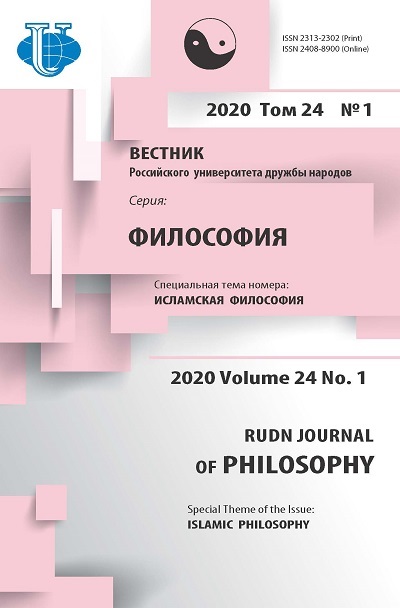Visual images of beauty of the word in the Persian poetry of XVI - the beginning of XVIII century: the Indian style and painting by word
- Authors: Reisner M.L.1
-
Affiliations:
- Lomonosov Moscow State University
- Issue: Vol 24, No 1 (2020): ISLAMIC PHILOSOPHY
- Pages: 12-22
- Section: ISLAMIC PHILOSOPHY
- URL: https://journals.rudn.ru/philosophy/article/view/23088
- DOI: https://doi.org/10.22363/2313-2302-2020-24-1-12-22
Cite item
Full Text
Abstract
The article is devoted to the problem of changing stylistic paradigm in the Persian poetry of XVI-XVII centuries and reflection of this process in self-consciousness of outstanding authors of the period. Parallel with preserving stable norms of traditional poetics literary practice demonstrates flexibility and forms new range of popular poetic strategies. New aesthetic criteria if ideal poetic language, expressed with epithet ‘colourful’ ( rangin ), appears alongside with criteria of previous period, expressed with epithet ‘sweet’ ( shirin ) and step by step gets leadership. Lyric poetry ( qhazal ) of three famous authors of the period of formation and golden age of Indian style served the object of analyses. The phenomena of visualization of imagery connected with perfect poetic language illustrated by examples of ‘Poet and Poetry’ motifs located in ‘frame text’ in end of the qhazal . These motifs serve one of the regular contexts of author’s name ( takhallus ) and show author’s attitude to his creation, including stylistic preferences. Refinement of poetic fantasy being declared basic condition of creating perfect poetry described visually as coiling lasso, poetry itself as flourishing garden, fountain or European house decorated with painting. Such characteristic of word creation has analogies in the works of Baroque style theorist Giambattista Marino (1569-1625).
About the authors
Marina L. Reisner
Lomonosov Moscow State University
Author for correspondence.
Email: marinareys@iaas.msu.ru
Doctor of Sciences (Literature), Professor of the Department of Iranian philology, Institute of Asian and African Studies
11 Mokhovaya str., Moscow, Russian Federation, 101999References
- Lihachev DS. Razvitie russkoj literatury X—XVII vv. Epohi i stili. Moscow; 1973. (In Russ.)
- Bahar Mohhammad Taki Malek ash-Sho‘ara. Sabkshenasi ja tarih-e tatavvor-e nasr-e farsi (Stilistika, ili Istorija razvitija persidskoj prozy). Vol.1—3. Teheran; 1376 (1998).
- Chernec LV, Halizev VE, Jesalnek AJa i dr. Vvedenie v literaturovedenie: uchebnik dlja stud. vyssh. ucheb. zavedenij pod red. LV Chernec. Moscow; 2010. (In Russ.)
- Rejsner ML. Zhanrovye tipy ramochnyh tekstov v persidskoj klassicheskoj pojezii (X— XV vv.) (Genre Types of “Frame texts” in the Persian Classic Poetry of the tenth to fifteenth centuries). Vostok (Orients). 2017;(5). (In Russ.)
- Sa‘di Shirazi. Divan-e gazalijat. Red. HH. Rahbar. Vol. 2. Teheran; 1374 (1996).
- Dzhami Abdarrahman. Tri divana. Kriticheskij tekst. Divan pervyj. Fatihat ash-shabab. Kriticheskij tekst i predislovie A. Afsahzoda. Moscow; 1978. (In Russ.)
- Nasir ad-Din Tusi. Mi‘jar al-ash‘ar. Teheran; 1320 (1942).
- Prigarina NI. Indijskij stil' i ego mesto v persidskoj literature (voprosy pojetiki) (Indian Style and its Role in Persian Literature [Poetic Related Problems]). Moscow; 1999. (In Russ.)
- Akimushkin OF. O funkcijah pojeticheskih sbornikov i al'bomov v srednevekovoj persidskoj i tadzhikskoj slovesnosti. Srednevekovyj Iran: Kul'tura, istorija, filologija. St Petersburg; 2004.
- Kalim Kashani. Divan. Teheran; 1369 (1991).
- Saib Tabrizi. Divan. Vol. 2. Teheran; 1374 (1996).
- Saib Tabrizi. Divan. Vol. 1. Teheran; 1374 (1996).
- Shavkati Buhoroi. Nuri asr. Dushanbe; 1986.
- Golenishhev-Kutuzov NI. Marino i ego shkola. Golenishhev-Kutuzov NI. Romanskie literatury. Moscow; 1975. (In Russ.)
















